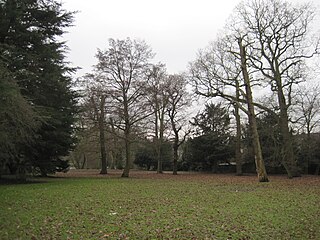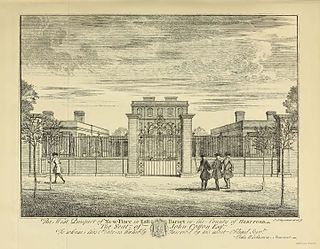
Greenhill was a house and estate on the site of the former Pricklers estate to the south of Chipping Barnet, on the borders of Hertfordshire and Middlesex, in what is now north London.

Greenhill was a house and estate on the site of the former Pricklers estate to the south of Chipping Barnet, on the borders of Hertfordshire and Middlesex, in what is now north London.
Pricklers was a large country estate named after a medieval family called Prittle. The estate was owned by the descendants of John Marsh, passing to Margaret Marsh when her father Captain William Marsh died. She married firstly John Nicholl, having a daughter by this marriage also called Margaret, and as a widow in 1694 married John Woolfe, soon to be knighted. Sir John and Dame Margaret Woolfe had issue of three daughters and a son Marsh Woolfe. [2] [ citation needed ]
On Dame Margaret's death in 1713 she left Pricklers to her son Marsh Woolfe, although he was then only thirteen years of age. Until he came of age, the estate was administered on his behalf by the executors of the will, namely Margaret Nicholl (Dame Margaret's daughter by a previous marriage) and John Godden Woolfe (Sir John Woolfe's son by a previous marriage). [3]
At that time the house was always called Pricklers by the family. Marsh Woolfe in turn left his estate in 1748 to his half-nephew by blood Thomas Brand of The Hoo, the son of Dame Margaret Woolfe`s daughter Margaret. [4]
A watercolour painting of the house was made in about 1800. [5]
Most of the land was developed for housing in the twentieth century. In 1926 East Barnet Council purchased the remaining land which is now Greenhill Gardens. [6] [7]

Sir James Montgomery, 1st Baronet Stanhope, FRSE was a Scottish advocate, judge, country landowner, agriculturalist and politician who sat in the House of Commons from 1766 to 1775. In 1783 he was a joint founder of the Royal Society of Edinburgh.

Abbots Langley is a large village and civil parish in the English county of Hertfordshire. It is an old settlement and is mentioned in the Domesday Book. Economically the village is closely linked to Watford and was formerly part of the Watford Rural District. Since 1974 it has been included in the Three Rivers district.
Boconnoc is a civil parish in Cornwall, England, United Kingdom, approximately four miles (6 km) east of the town of Lostwithiel. According to the 2011 census the parish had a population of 96.

Bulstrode is an English country house and its large park, located to the southwest of Gerrards Cross, Buckinghamshire. The estate spreads across Chalfont St Peter, Gerrards Cross and Fulmer, and predates the Norman conquest. Its name may originate from the Anglo-Saxon words burh (marsh) and stród (fort). The park and garden is designated a Grade II* listed building.

Somerford Hall is an 18th-century Palladian style mansion house at Brewood, Staffordshire. It is a Grade II* listed building.
Sir John Coxe Hippisley, 1st Baronet, was a British diplomat and politician who pursued an 'unflagging, though wholly unsuccessful, quest for office' which led King George III of Great Britain to describe him as 'that busy man' and 'the grand intriguer'.

Greenhill Gardens is a 1.6 hectare public park in New Barnet in the London Borough of Barnet. Its main feature is an ornamental lake with a wooded island, which attracts many birds, and it also has a grassed area with scattered mature trees. It is a site of local importance for nature conservation.

Tapeley is a historic estate in the parish of Westleigh in North Devon, England.
Sir Anthony Keck was an English lawyer and politician. He was a member of Parliament between 1691 and 1695, and served as Commissioner of the Great Seal from 1689 to 1690.
Thomas Brand (senior) was an English country landowner of The Hoo, Kimpton, Hertfordshire and politician who sat in the House of Commons from 1741 to 1770.

Chilworth Manor is a historic country house located midway between Chilworth, Surrey and St Martha's Hill to the north. The manor is grade II listed by Historic England.

Little Grove, originally Danegrove, was a house and estate that once existed in East Barnet on high ground to the south of Cat Hill. The original house on the site dated from at least the mid sixteenth century. In 1719, it was demolished and replaced with a house known as New Place but the house soon returned to the name of Little Grove. That house was demolished in 1932 to make way for a housing development and primary school known as Littlegrove.

Sandywell Park is an Jacobean Georgian manor house, five miles east of Cheltenham in Gloucestershire, England. Built in 1704 by Henry Brett, it was extended a few times over the 18th century. In the mid-eighteenth century the Sandywell Park estate acquired the Whittington Court building. Sandywell Park is today a Grade II* listed building.
Woodhouse Grammar School was a secondary school in Woodhouse Road, North Finchley, in the London Borough of Barnet.

Sir John Weld was a wealthy landowner and London merchant, the son of a Lord Mayor of London and the father of the branch of the Weld family which became settled at Lulworth Castle in Dorset. He was a charter member and Council assistant of the Newfoundland Company of 1610.

5, St James's Square is a Grade II* listed historic townhouse in London, England, built 1748–51 by William Wentworth, 2nd Earl of Strafford (1722–1791) to the design of Matthew Brettingham the Elder. It remained the London residence of the descendants of his sister until after 1968, and in 1984 was the site of the "Libyan Peoples' Bureau" from which shots were fired which caused the murder of Yvonne Fletcher.

Sir Walter Wrottesley, 3rd Baronet (c.1659–1712), of Wrottesley Hall, then in Tettenhall, today Perton, in Staffordshire, England.


Minchenden Oak Garden is a public park in Southgate, London owned by the London Borough of Enfield.

Willenhall House was a house and estate located to the south of Chipping Barnet, on the borders of Hertfordshire and Middlesex, in what is now north London. It was designed by John Buonarotti Papworth in 1829 for the East Indies merchant Thomas Wyatt to replace an existing house on a piece of land that was once part of the ancient Pricklers estate. Wyatt named it after Willenhall in the English West Midlands, the place of his birth. The house was demolished in 1890 and the site developed for housing over the following decades.
51°38′46″N0°10′52″W / 51.646°N 0.181°W